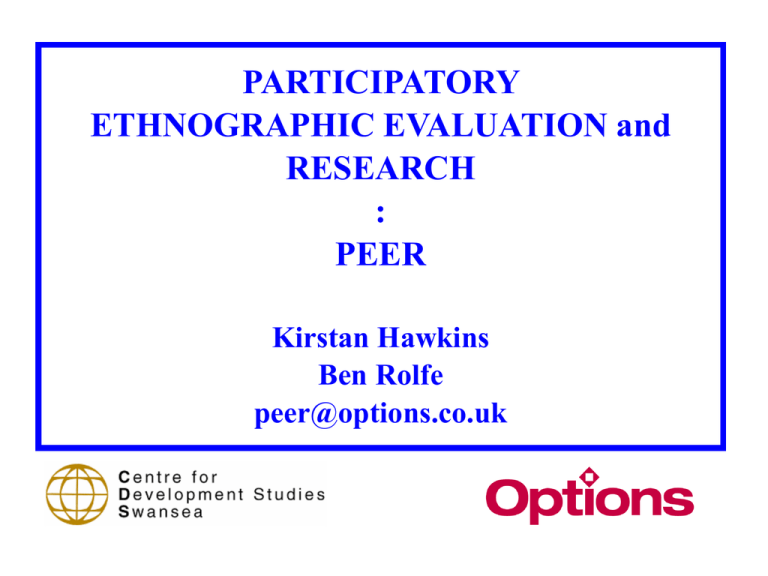
PARTICIPATORY
ETHNOGRAPHIC EVALUATION and
RESEARCH
:
PEER
Kirstan Hawkins
Ben Rolfe
peer@options.co.uk
SESSION 1
INTRODUCTION TO
THE PEER METHOD
PEER PRESENTATION
• Rationale for PEER
• Key principles of the method
• How does PEER differ from other
approaches?
• Types of data produced
• Reflections on PEER process
Participatory Ethnographic
Evaluation and Research
Rapid participatory method
• Social analysis: in-depth ‘grounded’ qualitative
data
• Monitoring: changes from perspective of target
community.
• Advocacy and accountability: Mechanism through
which to give voice to marginalised groups and
engage in active dialogue
• Communications: evidence based
Rationale
• Developed as a method for researching behaviour
and monitoring behaviour change
• Field of SRH research dominated by positivist
and empiricist research methods of demographic
research, such as sample surveys and focus groups
• First applied to researching sexual and
reproductive behaviour in the context of
HIV/AIDS prevention and reproductive health
programmes
Rationale
• Based on anthropological approach
• Aims to gain an in-depth understanding of the
social realities of people’s everyday lives through
collecting narratives of social network
• Standard methods tend to abstract people’s actions
from socio-cultural and political context in which
they takes place
• Criticises notion dominant within demographic
research that social behaviour is outcome of
individual assessments /choices – ie place in
context.
Where PEER has been used
• Cambodia, Myanmar, Rwanda, Mozambique
(PSI)- transactional sex -AIDS prevention
• Nepal – Safe motherhood Project –Monitoring
tool. Save, GTZ, Action Aid.
• India (PSI) – Transport workers / CSW’s
• Malawi – Young Women Access to VCT
• Zambia – HCP + NUI
• Ongoing: Haiti, Dominican Republic, Pakistan.
Principles of the method
• Research is undertaken
by members of target
community
• Carry out conversational
interviews with others in
their social network
Principles of the method
• Prompts designed by
peer researchers
during a short
participatory training
• Questions (prompts)
owned and relevant.
• Research focus
relevant and
meaningful
Principles of the method
Data analysed by
peer researchers
– Ownership
– Voice
– Clarify issues
Principles of the method
Multiple outputs:
– Formative
Research
– Monitoring
– Advocacy,
Empowerment &
Voice
Principles of the method
• Detailed social analysis carried out by
social scientist
• Produces quick actionable results in
three months
• Sustainable approach – build capacity
Define
Objectives
Develop
Themes
1 Day
Train
Researchers
3 Days
Field
Test
Interviews
Analysis
1 Day
5 Weeks
5 Days+
Outputs
•
•
•
•
•
Relevant evidence base
Communications strategy development
Creative brief
Entry points for behaviour change strategy
Foundations for community based
monitoring
Use of PEER
In-depth understanding of:
• Social organisation and social networks
• Decision making processes –beyond behaviour
• Livelihood strategies, sexual networking,
health seeking behaviour
• Power dynamics and how power relations are
experienced
Use of PEER
Practically:
• Understand processes of exclusion
– which groups are excluded from accessing resources, and
how
• Understand barriers to access to services
– and whether programmes are reaching poor and
marginalized groups
– Understand interactions between demand and supply sides
Dominican Republic:
BCC design and monitoring
Bateyes HIV prevention/social marketing:
Objectives of PEER:
• In-depth understanding of behaviour related to
logframe indicators: partner reduction and
increase condom use
• Actionable qualitative data to complement
baseline survey data
Survey Data: norms re partners
N total = 1500 men and women resident in bateys
Have had a regular sexual partner apart from
spouse in the last twelve months (N=1360)
Have had occasional sexual partner in
last twelve months (N=1360)
You think your spouse/partner has had
other sexual relations in the last twelve
months (N=957)
34.2%
20.9%
13.1%
Survey Data: partners and gender
Of those who had a regular partner
apart from spouse in last twelve
months. Percentage male
71.4%
Of those who had an occasional sexual
partner in last twelve months.
Percentage male.
87%
PEER Data
Social Norms: Men
2 competing norms
“Ideal” type of respectable behaviour (in relation to other
men):
• Hombre-serio – has only a few partners (e.g two families)
– supports partners financially.
Male identity in relation to women:
• Man must have many partners to be a man – important to
compete with each other for machismo
• Must be attractive to women – “vacano” – ie women must
want him (eg papi-chulo) – women want him to look good
and buy him things: chulo.
SOCIAL NORMS: Women
Norm of fidelity
• A respectable woman is a mujer de la casa – keeps the
home and looks after children
• A mujer de la casa is faithful to her husband
• A woman with many partners is a mujer de la calle
• Mujer de la calle are prostitutes – whether they have sex
directly for money (cueros) or with many amantes
• Women gossip about those who have lovers – call them
“cuernos / cuernula.”
• Women shun-reject other women who are known to have
several lovers
Actual behaviour: men
Men have multiple families and lovers – necessary to be a
man
Women not only accept but actively reinforce that men cannot
be faithful to one woman
• A man who is faithful to one woman is “palomo,
pariguayo, maricon.”
• From a woman’s perspective an hombre-serio does not
exist – no real man can be an hombre-serio.
• A woman would not consider looking at a man who
does not have other women
• A woman looks for a “tiguere” – a chulo/ papi-champu
Actual behaviour: women
• It is not economically viable for a woman to have
only one partner. A woman cannot economically
be supported by one man alone.
• Most women have one or more amantes for
financial support
• A woman must not openly have lovers.
• A woman who is “sabia” has lovers who support
her financially and lovers for pleasure
• Women may also have lovers for pleasure whom
they support financially (chulos)
Survey Data: condom
acceptability
• In your community it is alright to use
and be seen with condoms (N=1409)
86.4%
• In your community people think
that true/real men use condoms (N=1377)
83.5%
• In your community it is acceptable for
a woman to propose condom use (N=1421)
93.7%
Condom use
• Men and women reinforce that men should use
condoms with partners they do not trust (mujer de
la calle) to prevent AIDS.
• No woman identifies herself as mujer de la calle
• Women propose that men use condoms with other
women never with themselves
• People fear gossip that they may have AIDS (and
social exclusion) more than actual infection
For men condoms symbolise being
responsible and protective of mujer
de la casa from mujer de la calle
• A responsible man is hombre serio – other men respect
him. Responsible men use condoms
• Men use condoms with mujer de la calle – responsible men
do not go with mujer de la calle
• Women like chulo – papi-chulo
• Chulo want women to be attracted to them
• Chulo don’t use condoms because women don’t like them
and men don’t enjoy sex with condoms
• Men tell their friends they use condoms because they want
them to think they are responsible and not infected
For women condoms mean lack
of trust and symbolise infection .
–
–
–
–
–
–
–
–
Man suggests condom
Man does not trust me – I don’t trust him
He is probably infected
He is a bad person and wants to infect me
He will put holes in the condom and try to infect me
I would rather he never suggested it
If he doesn’t suggest it he must be healthy
If he is healthy it doesn’t matter how many partners he
has because he is not infected.
Recommendations
o Do not link condom-use messages with number of
partners
o Condom promotion messages need to move away
from messages of protection and towards
messages that condom use signifies being healthy
o Need multiple coordinated messages directed to
each population segment that will, in the
community itself, link up to change the current
stigma against a condom user into a stigma against
condom non-user.
• Managed by Options.
• DfID funded
– £20 million over 5 years
• Builds on Nepal Safer
Motherhood Project
(NSMP) 1997-2004
• A programme approach
working directly with
government.
• Capacity building MoH gradual assumption of full
responsibility for all activities
related to improving MCH,
including research,
monitoring and evaluation.
PEER and KIM
• A challenge to understand and monitor changes
in the social context in which pregnancy and
child-bearing take place.
• Term key informant (KI) is used, as the concept
of peers and peer networks limited meaning in
small highly stratified communities of rural
Nepal.
• Key informants not selected from one
homogenous group, but include women from
different castes, ethnicity, social status, age and
location.
KIM in 16 VDCs, every 12 months
R
R
Peer Researchers
Community
R
Village Level
District level
National level
VOICE
VOICE
VOICE
FORMATIVE
RESEARCH
FORMATIVE
RESEARCH
FORMATIVE
RESEARCH
MONITORING
MONITORING
MONITORING
Village Level
Village Level
R
R
Peer Researchers
Community
R
VOICE
FORMATIVE
RESEARCH
MONITORING
• VDCs allocated money
for emergency transport
• VDCs initiated the use
of curtains in the
examination rooms
• Some VDCs have
decided to have at least
33% women in
community groups, to
have stronger voices of
women in group
decision-making.
District Level
District Level
R
R
Peer Researchers
Community
R
•The process of the tool
and the findings have been
powerful.
VOICE
•Rigorous, credible and
practical.
FORMATIVE
RESEARCH
MONITORING
•A number of NGOs have
gone on to use the
approach independently.
National Level
National
Level
R
R
Peer Researchers
Community
R
VOICE
FORMATIVE
RESEARCH
•Significant impact –
refocused approach for SSMP
•More emphasis on
interaction, mothers-in-law,
husbands & women
•More demand side
interventions, focus on equity.
•#
MONITORING
•Credibility - the KIs are from
the community itself.
•Powerful stories. Voice.
Strengths
• Low cost method
– upfront costs in capacity building
• Carried out in private sphere
– a depth of understanding about sensitive issues
– beyond normative responses
• Tool for advocacy
– empowers marginalised groups to voice views
• Can provide an entry point
Risks and Cautions
• Does not produce quantifiable data. Does not replace
quantitative methods
• Initiates processes which can challenge existing
power relations
• Peer researchers may become biased in reporting
over time if they identify strongly with the
programme
• Effectiveness depends on appropriate selection of
peer researchers and clear objectives.
• Turning insight into interventions requires capacity.






